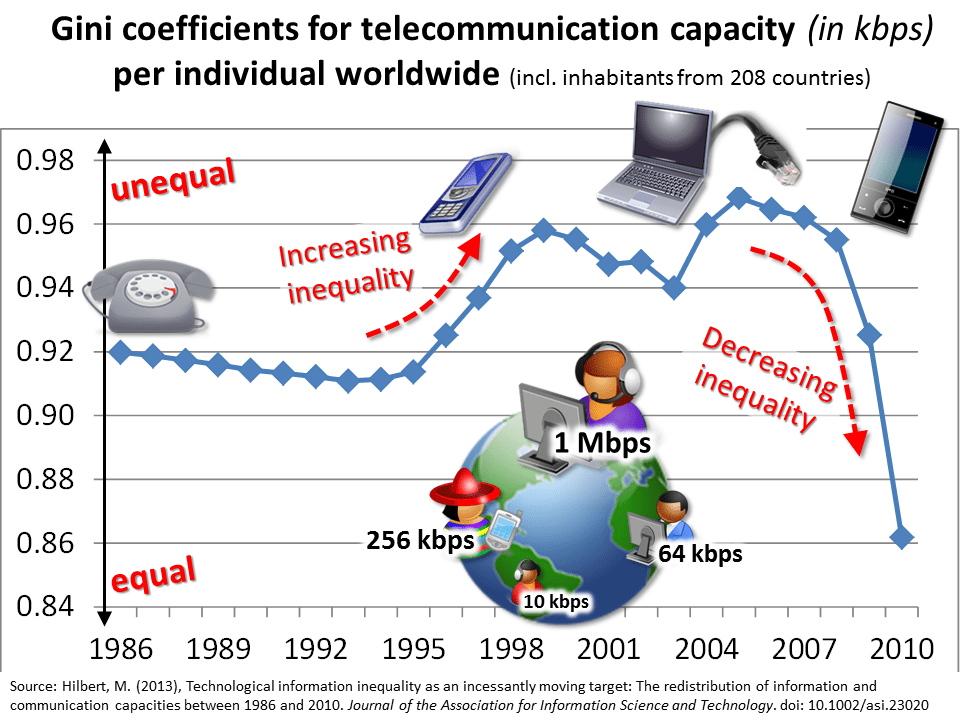Technology is everywhere, yet not everyone has the same level of access. This gap in access is often called the digital divide. Recognizing how it emerges and why it matters can help inform decisions about computing, education, and fairness in today’s world. Therefore, understanding the digital divide is critical for anyone studying computer science or simply navigating modern society.
What We Review
What is the Digital Divide?
The digital divide refers to differing access to computing devices and the internet based on socioeconomic, geographic, or demographic characteristics. For example, think of two students doing research for a school project. One has a stable internet connection at home and a personal laptop, while the other must visit the local library’s limited-hour computer lab. As a result, their access to study materials is vastly different.
This divide can affect both groups and individuals. Globally, entire regions may lack high-speed internet, making it harder for businesses and schools to operate efficiently. Locally, families with lower incomes might not afford the latest devices, causing students to fall behind academically. Therefore, the digital divide raises questions of equity, access, and influence around the globe.

Causes of the Digital Divide
1. Socioeconomic Factors
Income and financial resources often shape how frequently technology can be purchased and upgraded. For instance, low-income households might share a single phone for all their online tasks, including homework and job searches. Consequently, limited access can slow down progress in education or career paths.
Affordable devices and community programs can help bridge this gap. However, long-term solutions involve policies and initiatives that address the root cause of income inequality.
2. Geographic Factors
Where someone lives greatly affects their internet connectivity. In rural regions, high-speed internet cables or mobile data towers might be scarce. As a result, these communities often rely on slow dial-up connections or have no access at all. Cities typically have stronger infrastructure, offering more options for fast, reliable internet. However, a remote farming community might depend on satellite internet, which can be expensive and prone to service interruptions during storms.
This is why local governments often invest in broadband expansion projects. By building more internet infrastructure, rural areas gain the same advantages available in urban settings.
3. Demographic Factors
Age, education level, and race also play important roles in the digital divide. Older adults may not feel comfortable navigating digital tools, while those with fewer educational opportunities may not realize the advantages of internet access. Furthermore, certain racial groups face barriers that stem from historical inequalities, making it harder to afford technology. For example, senior citizens might rely on public libraries or community centers for internet access. Some communities address this with tech training workshops that cater specifically to older adults.
By understanding these demographic factors, it becomes clearer why tailored programs are necessary. For instance, offering bilingual tech support can help non-English speakers connect more easily.
Effects of the Digital Divide
The consequences of the digital divide can be significant. Education suffers when students lack the online tools needed to research or to complete assignments. Additionally, job-seekers may miss opportunities if employment listings and applications are primarily available online. This gap can also exacerbate social inequality because those without internet access may become isolated from news, healthcare options, and community resources.
For example, consider a job-hunting scenario where applicants must fill out an online form. People without reliable internet might lose out simply because they submitted the application late or had to visit a public computer lab with limited hours. Consequently, the digital divide can amplify existing inequities and keep disadvantaged groups from flourishing in an increasingly digital economy.
Addressing the Digital Divide
1. Individual Actions
Individuals can take steps to narrow the digital divide in their communities. For instance, donating unused devices like tablets or laptops can make a huge difference for someone who cannot afford such tools. In addition, volunteering at local libraries to teach basic tech skills can empower those who feel intimidated by the digital world.
- Explore Your Resources: Many libraries offer free internet access and computer stations.
- Encourage Sharing: Families can pool resources or share devices to help each other stay connected.
- Teach and Learn: Organizing informal training sessions helps others gain the technological confidence they need.
2. Organizational Efforts
Companies and nonprofits often launch programs to provide discounted or free services. Some internet providers offer reduced-rate plans for students or low-income households. Moreover, nonprofits may donate equipment to communities in need, ensuring that students can keep up with online coursework.
- Company Initiatives: Big tech companies might partner with local schools to supply devices or set up free Wi-Fi hotspots.
- Nonprofit Partnerships: Organizations team up with community centers to distribute refurbished laptops and teach digital skills.
These efforts can be directed toward specific neighborhoods or demographic groups, making targeted progress in bridging the divide.
3. Government Initiatives
Governments can play a major role by funding internet accessibility projects. Many regions have rolled out broadband expansion plans, particularly in rural areas, to ensure high-speed internet is not limited to big cities. In addition, some states or municipalities offer grants to help schools update their computer labs.
- Government Programs: Subsidies for low-cost internet or device purchases can help underprivileged families.
- Example: Some cities provide free Wi-Fi in public spaces, encouraging residents to engage in digital learning or job searches.
By working together with community leaders and tech companies, governments can set policies that strengthen infrastructure, making the internet a resource for everyone.
Key Terms to Know
- Digital Divide – Differing access to devices and the internet based on socioeconomic, geographic, or demographic factors
- Socioeconomic Factors – Conditions related to income and financial status that influence technology accessibility
- Geographic Factors – Physical location variables, such as rural or urban settings, affecting internet availability
- Demographic Factors – Attributes like age or race that can shape an individual’s tech usage and access
- Equity – Ensuring fair opportunity and resources, including technology, for everyone
- Infrastructure – The physical and organizational structures needed for society to operate, such as internet cables and networking technology
Conclusion
The digital divide is more than just a technical issue—it’s a broader concern that touches on fairness, progress, and the right to learn and thrive in a digital society. After exploring what the digital divide is, why it happens, and how it affects communities worldwide, it becomes clear that equitable access to computing devices and the internet benefits all. In short, careful understanding plus collaborative action can bring about significant change, ensuring that no one is left out of the digital future.
Sharpen Your Skills for AP® Computer Science Principles
Are you preparing for the AP® Computer Science Principles test? We’ve got you covered! Try our review articles designed to help you confidently tackle real-world AP® Computer Science Principles questions. You’ll find everything you need to succeed, from quick tips to detailed strategies. Start exploring now!
Need help preparing for your AP® Computer Science Principles exam?
Albert has hundreds of AP® Computer Science Principles practice questions and full-length practice tests to try out.








